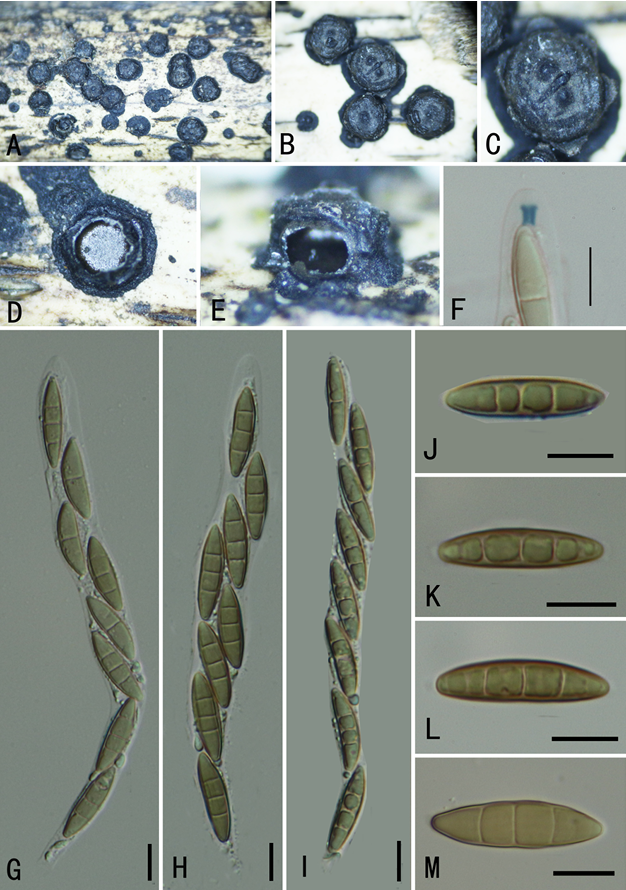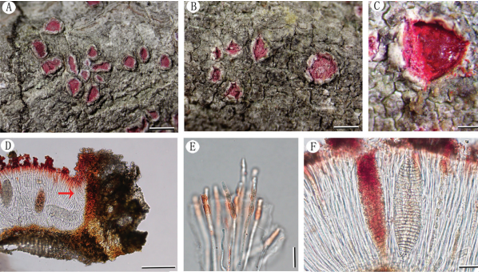Cortinarius sinensis L.H. Sun, T.Z. Wei & Y.J. Yao 2020
Fungal Name number: FN 570647; Facesoffungi number: FoF 06101
Holotype: CHINA, Qinghai Province, Qilian County, Zhamashi Town, on ground in coniferous forest with Picea sp., alt. 2950 m, 21 August 2004, Qing-Bin Wang 444 (HMAS99105, holotype), Qing-Bin Wang 453 (HMAS99070), Qing-Bin Wang 454–1 (HMAS96980), Qing-Bin Wang 454 (HMAS96985), Liang-Dong Guo & Ying Zhang 624 (HMAS99446), Hua-An Wen 04,312 (HMAS138964), Hua-An Wen & Mao-Xin Zhou 4298 (HMAS144904); Babao Town, on ground in coniferous forest, 20 August 2004, Qing-Bin Wang 416 (HMAS96987), Qing-Bin Wang 416-1 (HMAS96988); Datong County, Dongxia Forest Station, alt. 3000 m, on ground in coniferous forest, 17 August 2004, Qing-Bin Wang 356 (HMAS99090), Qing-Bin Wang 356–1 (HMAS99102); Gansu Province, Tianzhu County, Huangyangchuan Town, Nanchong Forest Protection Station, on ground in coniferous forest with Picea crassifolia, 37°15′38″ N, 103°3′58″ E, alt. 2900 m, 25 August 2016, Li-Hua Sun, Q61, HMAS279889, Li-Hua Sun, Q62, HMAS279890, Li-Hua Sun, Q63, HMAS279891, Li-Hu a Sun, Q66, HMAS279893, Li-Hua Sun, Q78, HMAS279900, Li-Hua Sun, Q80, HMAS279902, Li-Hua Sun, Q83, HMAS279905, Li-Hua Sun, Q84, HMAS279906, Li-Hua Sun, Q85, HMAS279907; Ningxia Autonomous Region, Helanshan Mountains, August 2007, Hua-An Wen (HMAS187061); The Inner Mongolia Autonomous Region, Alxa Left Banner, Helan Mountains, August 2016, Li-Hua Sun 89, HMAS279888.
Morphological description
Basidiocarps gregarious. Pileus 7–11 diam, up to 16 cm diam, first hemispherical, then convex, finally convex-applanate to applanate, sometimes with depressed center; margin decurrent to straight; surface greyish brown to purplish brown when young and sometimes with olive tint, reddish brown with purplish tint (Brick Red to Garnet Brown) to purple brown (Deep Livid Brown) when mature, margin paling to greyish brown (Buckthorn Brown), yellowish brown (Ochraceous-Tawny) to brown (Tawny to Sanford’s Brown), mostly with dark purplish brown squamules or speckles (Dark Purple Drab) from universal veil, fibrillose-striate, smooth, shiny, viscid when moist. Lamellae adnate to emarginate-adnate, 5–17 mm wide; yellowish (Pale OchraceousSalmon) to brownish (Colonial Buff) when young, then yellowish brown (Ochraceous-Tawny) to brown with rust tint (Tawny), crowded, with lamellulae. Stipe 5–9 × 1.5–2.5 cm, central, cylindrical with a marginate-bulbous base up to 3.5 cm across; surface pale brown (Light OchraceousBuff), yellowish brown (Yellow Ocher) to brown (Tawny) and mostly whitish at upper part, brown (Tawny), reddish brown (Brazil Brown) to purplish brown (Garnet Brown) at base, rough, attached rust brown fibrils of universal veil; solid to soft. Cortina almost whitish to purplish when young and greyish purple when dry, finally rust brown with purple tint. Universal veil covering whole of basidiocarp, purplish when young, strongly purple when mature (especially in exsiccata). Context up to 2.5 cm thick at center of pileus, whitish, fleshy. Smell not distinctive. Taste mild. Spore print rust brown. Chemical reaction with 20% KOH dark reddish brown. Fluorescence reaction under ultraviolet light indistinct. Basidiospores (8.5–)9–12.5(–14) × (5.5–)6–7(–7. 5) μm, Q = 1.4–1.8 (x = 1.6); subglobose, yellow–brown, dis-̅ tinctly verrucose. Basidia 26–32 × 6–8.5 μm, clavate, thinwalled, mostly subhyaline, with four sterigmata. Lamella margin heterogeneous, with sterile cells, 20–30 × 5–7 μm, clavate, subhyaline, thin-walled. Cheilocystidia and pleurocystidia none. Pileipellis of brown hyphae, 2–6 μm diam, thin walled. Clamp connections present in all tissues.
Habitat: On ground in coniferous forest with Picea sp.
Distribution: In China.
GenBank Accession: ITS: MK411466, MK411462, MK411473, MK411471, MK411472, MK411468, MK411469, MK411464, MK411470, MK411467, MK411463, MK411452, MK41145, MK411454, MK411455, MK411456, MK411457, MK411458, MK411459, MK411460, MK411465, MK411461.
Notes: Cortinarius sinensis is a species of subgenus Phlegmacium (Fr.) Trog because of its visicid pileus and distinguished from other species in the subgenus by its purplish pileus and universal veil. Phylogenetically, C. sinensis formed a clade with C. cupreorufus Brandrud and C. pseudocupreorufus Niskanen, Liimat. & Ammirati (Fig. 80), but the ITS sequences of C. sinensis deviate from that of these two species in the phylogenic tree by at least 11 substitutions and indel positions. Furthermore, C. cupreorufus (Breitenbach & Kränzlin 2000; Gutiérrez et al. 2006) and C. pseudocupreorufus (Smith 1944; Liimatainen et al. 2014) do not have purple colours. Morphologically, the species is similar to C. rufoolivaceus (Pers.) Fr., which also has a lilac to purplish-tinged pileus (Breitenbach and Kränzlin 2000; Bidaud et al. 2004; Soop 2018), however, compared with this species the new taxon has a much stronger purple coloration especially of the universal veil. C. sinensis is an edible species and is consumed by people in the Helan Mountain area, Ningxia Autonomous Region.
Reference: Hai‑Sheng Yuan1,2· Xu Lu1,2 · Yu‑Cheng Dai3 ·

New Cortinarius species from China. a, b. C. sinensis (HMAS 99105, holotype). a Basidiocarps. b Basidiospores. c, d C. subsanguineus (HMAS 250503, holotype). c Basidiocarps. d Basid- iospores. e, f. C. xiaojinensis (HMAS 274355, holotype). e Basidiocarps. f Basidiospores. Scale bar: a,c,e=2 cm, b,d,f=10 µm









